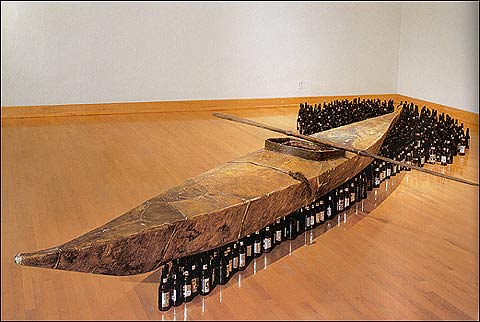University Art Museum, UCSB,
Oct 10, 2000 - Dec 16, 2000
Santa Barbara, CA , USA
Cuba: A narrative walkthrough of the exhibition
by Cynthia MacMullin
Pedro Alvarez is a painter who appropriates and combines images from the layers of Cuba's history of the colonial period, through the mid-nineteenth century, to the Revolutionary era. The paintings examine Revolutionary ideals--ideals rooted in efforts to create justice and equality. His painting in the exhibition, High, Low, Left and Right: Homage to the French Revolution, displays three monochromatic panels painted in red, white, and blue, representative of the flags of France, Cuba, and the United States. These three countries historically underwent popular revolutions to overturn previously oppressive governments. Each image is drawn from a popular magazine of the 1950s, depicting the modern interior of a living room, dining room, and bedroom. Alvarez appropriated these interiors from Cuba's Bohemia magazine, which was published immediately after the victory of the Revolution. Often capitalistic advertisements were run adjacent to gruesome editorials of revolutionary battles and tales of heroism. In the central panel, a kitsch image taken from a cigar box label of the Statue of Liberty with Spanish and French attributes, stands in the room as if surprised by her new setting of bourgeois trappings. She seems to ask, "After all the sacrifices, the carnage of war, the guillotine, are these the fruits of revolution? Is this all?" With the ideals of the revolution unfulfilled, material gratification seems to appear more attractive. Alvarez' meticulously decorated rooms are monuments to capitalist gratification, however, even they can not suffice as substitutes for the elusive utopian ideals. He pays homage to the liberty gained from both the eras of Independence (won briefly in 1898) and of the Revolution of 1959. His paintings often juxtapose the heroic and the sentimental, in the tradition of the nineteenth-century costumbrista painter Victor Landaluze as well as that of American illustrator Norman Rockwell.
Image 2 Image 3 Image 4
Los Carpinteros or The Carpenters are a group of three artists, Alexander Arrechea (b. 1970), Marcos Castillo Valdés (b. 1970) and Dagoberto Rodriguez Sánchez(b.1969) who are concerned with the collective consciousness and historic social issues. Their imagery often questions the lingering effects of colonialism's slave trade, and current economic shortages. The exhibiting work Flying Pigeon is formed of a hand carved wood relief of a train engine and it's following passenger car-- a painting depicting an Afro-Cuban man (artist Alexander Arrechea) peddling a bicycle cab under the protection of an umbrella. He is riding a Flying Pigeon, a brand of Chinese bicycles imported to Cuba after the Soviet breakup, to compensate for the lack of motorized transportation. The coupling of the bicycle and rider suggests a relationship of human to machine, with human effort propelling the engine and the Cuban economy. The train, once a symbol of Cuban advancement, is now an unreliable and failing system of transportation. Flying Pigeon could be read as a commentary on priorities, mismanagement of resources, and manipulation of policies. Also the train transported the main export of Cuba, sugar cane. Since colonial time much of Cubas daily labor was drawn from imported African slaves to work the sugar cane plantations. The sugar mills became centers for slave trade creating an economic system of both a sugar economy and a slave economy. In this cycle, human labor became a valuable commodity on the world market and created a demand for slaves. As Hugh Thomas points out, Cuba became "not a sugar palace, but a sugar prison." The revolution sought to change these standards, and Los Carpinteros subtly comments on the successes and failures of capitalism and socialism.
Image 5
|









